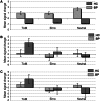Neuronal correlates of social cognition in borderline personality disorder
- PMID: 22362841
- PMCID: PMC3682436
- DOI: 10.1093/scan/nss028
Neuronal correlates of social cognition in borderline personality disorder
Abstract
Patients with borderline personality disorder (BPD) have severe problems in social interactions that might be caused by deficits in social cognition. Since the findings about social-cognitive abilities in BPD are inhomogeneous, ranging from deficits to superior abilities, we aimed to investigate the neuronal basis of social cognition in BPD. We applied a paradigm with three social cognition tasks, differing in their complexity: basal processing of faces with a neutral expression, recognition of emotions, and attribution of emotional intentions (affective ToM). A total of 13 patients with BPD and 13 healthy matched controls (HCs) were included in a functional magnet resonance imaging study. BPD patients showed no deficits in social cognition on the behavioral level. However, while HCs showed increasing activation in areas of the mirror neuron system with increasing complexity in the social-cognitive task, BPD patients had hypoactivation in these areas and hyperactivation in the amygdala which were not modulated by task complexity. This activation pattern seems to reflect an enhanced emotional approach in the processing of social stimuli in BPD that allows good performance in standardized social-cognitive tasks, but might be the basis of social-cognitive deficits in real-life social interactions.
Keywords: amygdala; borderline personality disorder; functional magnetic resonance imaging; mirror neuron system; social cognition.
Figures



References
-
- Adolphs R, Spezio M. Role of the amygdala in processing visual social stimuli. Progress in Brain Research. 2006;156:363–78. - PubMed
-
- Arntz A, Bernstein D, Oorschot M, Schobre P. Theory of mind in borderline and cluster-C personality disorder. The Journal of Nervous and Mental Disease. 2009;197(11):801–7. - PubMed
-
- Barnow S, Stopsack M, Grabe HJ, et al. Interpersonal evaluation bias in borderline personality disorder. Behaviour Research and Therapy. 2009;47(5):359–65. - PubMed
-
- Baron-Cohen S, Ring HA, Wheelwright S, et al. Social intelligence in the normal and autistic brain: an fMRI study. European Journal of Neuroscience. 1999;11(6):1891–8. - PubMed
-
- Beck AT, Steer RA, Ball R, Ranieri W. Comparison of Beck Depression Inventories-IA and -II in psychiatric outpatients. Journal of Personality Assessment. 1996;67(3):588–97. - PubMed

